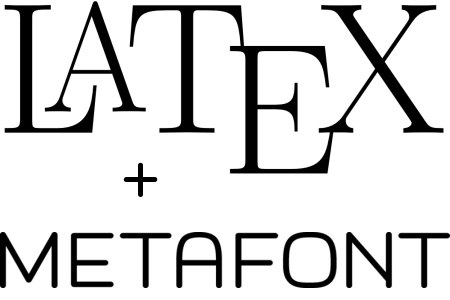LaTeX + metafont

99% of todays math literature are typeset with a typesetting language called “LaTeX”. There is basically no other way nowadays to publish mathematical texts in a decent form. In earlier times publishing mathematical texts was tedious.
 |
|
From the Disquisitiones Arithmeticae by Gauss in 1801
|
Sometimes an article got published by a journal with an editor who could afford beautiful mathematical typesetting like in the left image in Gauss’ work Disquisitiones Arithmeticae from 1801. (As a little side comment: The full works of Gauss are scanned in by the state and university library Goettingen, which already scanned in about 12000 books in high quality. Probably the library is not having the same problems as google with french editors…:-)). However sometimes there where no extra mathematical metal types, so formulas where included by hand. This holds especially true for the advent of typewriters: usually a secretary typed the text and the mathematician inserted the missing formulas by hand (a lot of math literature from last century has been written in this style). With the growing use of computers also various math typesetting programs came on the market (like e.g. the program EXP :-O) , but the by far most sucessful programs were TeX , developped by Donald Knuth in 1982 with its plain macro package and its modified macro package LaTeX written in 1984 by Leslie Lamport. Both packages are based on the same TeX programming language and used by default fonts made with Donald Knuths ingenious METAFONT program. Metafont is basically a program which allows the generation/programming of vectorized fonttypes which then get rastered by the system for a required resolution or output device. Since these types are “vectorized” there actual form (like size slant etc.) can be controlled via parameters. A demonstration about changing parameters in a fonttype created with metafond can be found in our gif animation surrealey.
Although Donald Knuth collaborated with graphics designer Hermann Zapf (creator of Palatino and Optima) metafont and LaTeX/TeX seem not so well perceived by the typography community. Knuth attributes this to the fact that “asking an artist to become enough of a mathematician to understand how to write a font with 60 parameters is too much” (in Donald E. Knuth. Questions and Answers II, TUGboat 17 (1996), 355–367).
However this may change. I was very enchanted to have recently read in John Maeda’s blog that he recommends his students to use LaTeX for editing! Let see when they start to use Metafont :-)…
January 10th, 2007 at 9:56 pm
[…] In contrast to this WYChIWYG means that you see the possibilities but what you are going to get is not clear unless you choose the final outcome. In terms of shopping this means: if you went lets say hundred years ago into a mom-and-pop store in the western world and if you had the intention to by sugar then you would get sugar. Nowadays you will have to choose from at least 6 different sugar brands. Takes a lot of energy. Even more: In a new design paradigma you have even to choose the design of your product, means if you want a bike then often you can choose not only the brands but also the parts, form, function etc of the bike. This holds also true for the computer-WYChIWYG, i.e. if I type in “:)” then php can link this to basically everything you want: from freely designed round smilies to straight jackets (a bit exagerated ) (see also LaTeX). Similar things hold for religion in modern worlds: Whereas in earlier times you had to live according to the religion of the place you lived in, you can nowadays choose what and even how you nourish your spirituality (if it exists). Even the development of democracies could be seen to fall under this trend. physics/math: quantum computers (also here. More on this maybe later). […]